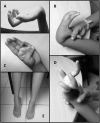A novel variant in the COL6A1 gene causing Ullrich congenital muscular dystrophy in a consanguineous family: a case report
- PMID: 33750322
- PMCID: PMC7941924
- DOI: 10.1186/s12883-021-02134-7
A novel variant in the COL6A1 gene causing Ullrich congenital muscular dystrophy in a consanguineous family: a case report
Abstract
Background: Collagen VI-related dystrophies are a subtype of congenital muscular dystrophy caused by pathogenic variants in COL6A1, COL6A2 or COL6A3 genes affecting skeletal muscles and connective tissue. The clinical phenotype ranges from the milder Bethlem myopathy to the severe Ullrich congenital muscular dystrophy (UCMD). Herein, we report the first consanguineous Sri Lankan family with two children affected with UCMD due to a novel variant in the COL6A1 gene.
Case presentation: Two sisters, aged 10-years and 7-years, presented with progressive, bilateral proximal muscle weakness. Both probands had delayed motor milestones and demonstrated difficulty in standing from a squatting position, climbing stairs and raising arms above the shoulders. Cognitive, language and social development were age appropriate. Examination showed proximal muscle weakness of the upper and lower extremities and hyperlaxity of the wrist and fingers in both with some variability in clinical severity noted between the two siblings. Serum creatine kinase levels were elevated, and electromyography showed low polyphasic motor unit potentials in the 10-year-old and myopathic features with short duration motor unit potentials with no polyphasia in the 7-year-old. Whole exome sequencing (WES) was performed and a novel, homozygous missense, likely pathogenic variant in exon 25 of COL6A1 gene [NM_001848: c.1667G > T;NP_001839.2:p.Gly556Val] was identified in both probands. This variant was validated by Sanger sequencing in proband 1 as well as proband 2, and the parents and an unaffected sibling were found to be heterozygote carriers for the same variant.
Conclusions: The findings in this family add to the expanding number of COL6A1 variants identified and provides a better understanding of the genotype-phenotype correlations associated with UCMD.
Keywords: COL6A1; Case report; Collagen type VI; Consanguineous; Myopathy; Phenotypic heterogeneity; Ullrich congenital muscular dystrophy.
Conflict of interest statement
The authors declare that they have no competing interests.
Figures


References
-
- Ullrich Kongenitale atonisch-sklerotische Muskeldystrophie. Monatsschr Kinderheilkd. 1930;47:502–510.
Publication types
MeSH terms
Substances
Supplementary concepts
LinkOut - more resources
Full Text Sources
Other Literature Sources
Medical
Miscellaneous

